Create a mental map using landmarks and major streets to navigate high-density urban areas. Employ dead reckoning techniques in GPS-denied environments. Stay alert for hazards like unstable structures and chemical spills. Use thermal imaging to locate victims in collapsed buildings. Implement clear communication strategies for signal-challenged zones. Utilize algorithm-based route planning for efficient search patterns. Coordinate multiple drones for broader coverage. Process real-time data from various sensors for in-depth insights. Adapt to diverse weather conditions with proper gear and training. By mastering these skills, you'll enhance your effectiveness in urban search and rescue missions. The following tips will further refine your navigation abilities.
Mapping High-Density Urban Areas

When traversing high-density urban areas, creating a mental map is essential. As you navigate through crowded streets and towering buildings, pay attention to distinctive landmarks, street names, and intersections. You'll want to identify major thoroughfares and note their orientation, as these can serve as your primary reference points.
Take note of unique architectural features, public squares, or prominent businesses that stand out. These can act as anchors for your mental map, helping you maintain your bearings. As you move, try to visualize the area from a bird's-eye view, placing these landmarks in relation to each other.
Don't rely solely on GPS technology, as signals can be unreliable in urban canyons. Instead, use physical maps or pre-downloaded offline maps as backups. Familiarize yourself with the neighborhood's grid system, if one exists, and learn how addresses are organized.
Pay attention to the flow of foot traffic and public transportation routes. These can indicate important hubs or destinations.
Obstacle Detection and Avoidance

When traversing urban search environments, you'll need to sharpen your ability to detect debris and rubble.
Keep your eyes peeled for unstable structures, fallen objects, and hazardous materials that could impede your progress or pose safety risks.
You should also learn to quickly identify areas that are too dangerous to enter, such as buildings on the verge of collapse or zones with potential chemical spills.
Debris and Rubble Detection
Maneuvering through urban areas after a disaster requires keen awareness of your surroundings. When it comes to debris and rubble detection, you'll need to stay vigilant and use multiple senses.
Look for unusual shapes, colors, or textures that don't belong in the environment. Pay attention to shadows and irregular patterns that might indicate collapsed structures or hidden hazards.
Listen for creaking, shifting, or settling sounds that could signal unstable debris. Use your sense of smell to detect potential gas leaks or other hazardous materials. If possible, employ thermal imaging cameras to identify heat signatures of trapped individuals or dangerous hotspots.
As you navigate, constantly assess the stability of the terrain. Look for signs of recent movement, such as fresh cracks, dust, or disturbed surfaces. Be cautious of seemingly stable areas that could collapse under your weight.
Use a long pole or stick to probe the ground ahead, testing for hidden voids or weak spots. Remember that debris can shift unexpectedly, so maintain situational awareness at all times.
If you're part of a team, communicate regularly about potential hazards and changes in the environment.
Hazardous Area Identification
Four key factors contribute to effective hazardous area identification in urban search exploration: visual cues, environmental indicators, situational awareness, and technological aids.
When maneuvering through urban disaster zones, you'll need to stay alert for visual cues like structural damage, exposed wiring, or unstable debris. These signs can indicate potential hazards that aren't immediately apparent.
Environmental indicators are equally vital. Pay attention to unusual odors, smoke, or changes in temperature, as they might signal chemical leaks, fires, or other dangers. Listen for creaking sounds or sudden noises that could warn of impending collapses.
Maintain situational awareness by constantly evaluating your surroundings. Be mindful of your team's position and potential escape routes. Don't forget to look up, as falling objects pose a significant threat in urban search scenarios.
Utilize technological aids to enhance your hazard detection capabilities. Thermal imaging cameras can reveal hidden heat sources, while gas detectors can identify invisible but dangerous airborne substances.
GPS devices and digital maps can help you track and mark hazardous areas, ensuring you and your team avoid them during future operations.
GPS-Denied Environment Navigation

When GPS signals are unavailable or unreliable in urban environments, you'll need alternative navigation methods.
You can employ dead reckoning techniques, using your known starting point, estimated speed, and direction of travel to calculate your current position.
Additionally, you should practice visual landmark recognition, identifying and remembering distinct buildings, signs, or other urban features to orient yourself and maintain awareness of your location.
Dead Reckoning Techniques
Dead reckoning is an essential skill for urban navigation when GPS signals are unavailable or unreliable. To use this technique, you'll need to keep track of your direction and distance traveled from a known starting point.
Start by orienting yourself using landmarks or a compass, then count your steps as you move. You can estimate distance by knowing your average stride length.
Maintain awareness of your surroundings and note any turns you make, recording the direction and approximate angle. Use a small notebook or smartphone app to log your movements. Pay attention to visual cues like street signs, building numbers, and distinct architectural features to confirm your position.
To improve accuracy, practice pacing and estimating distances in various environments. Learn to account for factors like fatigue, terrain, and obstacles that may affect your pace.
Combine dead reckoning with other navigation methods, such as map reading and landmark recognition, for better results. Remember that errors can accumulate over time, so periodically verify your position using identifiable reference points.
With practice, you'll develop a more intuitive sense of distance and direction, enhancing your urban navigation skills in GPS-denied environments.
Visual Landmark Recognition
Visual landmark recognition complements dead reckoning in GPS-denied environments. It involves identifying and using distinctive features in your surroundings to navigate. You'll need to train your eye to spot unique buildings, structures, or natural elements that stand out from the urban landscape.
To effectively use visual landmarks:
- Scan your environment for easily identifiable features
- Mentally note their relative positions and distances
- Use these landmarks to create a mental map of the area
Remember, effective landmarks should be:
| Characteristic | Description | Example |
|---|---|---|
| Distinctive | Unique and easily recognizable | Oddly shaped building |
| Permanent | Unlikely to change or move | Historic monument |
| Visible | Easily seen from various angles | Tall radio tower |
As you move through the urban environment, continuously update your mental map. Look for new landmarks and reassess your position relative to known ones. This technique works best when combined with other navigation methods, such as dead reckoning or sun positioning. By honing your visual landmark recognition skills, you'll improve your ability to navigate confidently in GPS-denied urban settings during search and rescue missions.
Thermal Imaging for Victim Location

Thermal imaging frequently proves invaluable in urban search and rescue operations. This technology allows you to detect heat signatures of survivors trapped in collapsed buildings or hidden under debris. When using thermal cameras, focus on areas that show temperature differences, as these can indicate the presence of a living person.
You'll need to understand how to interpret thermal images correctly. Look for human-shaped heat patterns, which often appear as bright spots against cooler backgrounds. Remember that victims may be partially obscured, so pay attention to even small heat signatures. Be aware that recent physical activity can leave residual heat traces, potentially leading to false positives.
To maximize the effectiveness of thermal imaging, scan methodically and slowly. Cover all angles of a structure, including voids and spaces between debris. Don't forget to check vertical surfaces, as victims may be trapped in multi-story collapses.
Use the device in conjunction with other search methods, such as acoustic listening devices and search dogs, for a thorough approach. In smoky or dusty conditions, thermal imaging can help you navigate more safely while searching for survivors.
Communication in Signal-Challenged Zones

In urban search and rescue operations, you'll often face areas where standard communication methods fail. These signal-challenged zones can impede your team's effectiveness and safety. To overcome these obstacles, you'll need to employ alternative communication strategies.
First, establish a clear chain of command and predetermined hand signals. This guarantees that even without verbal communication, your team can coordinate effectively.
Next, utilize portable radio repeaters to extend your communication range in areas with limited signal. These devices can greatly boost your ability to stay connected in challenging environments.
Consider implementing these additional communication tools:
- Mesh networks: Create a decentralized network that allows devices to relay messages
- Satellite phones: Maintain communication in areas without cellular coverage
- Visual markers: Use high-visibility tape or glow sticks to mark cleared areas
- Sound-based signals: Employ whistles or air horns for emergency alerts
Remember to brief your team on all communication protocols before entering the field.
Regular practice with these methods will improve your team's proficiency and readiness. By adapting your communication strategies to signal-challenged zones, you'll enhance your urban search and rescue capabilities, potentially saving more lives in critical situations.
Battery Management for Extended Missions

Effective battery management is essential for extended urban search and rescue missions. You'll need to prioritize power conservation to guarantee your devices last throughout the operation.
Start by fully charging all equipment before deployment and carry spare batteries or portable power banks for critical devices. Disable unnecessary features on your smartphones and radios to extend battery life, such as Wi-Fi, Bluetooth, and GPS when not in use.
Dim your screen brightness and use airplane mode when possible to conserve power. Consider using energy-efficient LED headlamps and flashlights, which consume less battery power than traditional lighting.
If you're using thermal imaging cameras or other specialized equipment, bring extra batteries and rotate their use to prevent complete drainage.
In cold environments, keep batteries warm by storing them close to your body when not in use. For extended missions, bring solar chargers or hand-crank generators as backup power sources.
Establish a battery management protocol within your team, designating specific times for charging and device usage. This will help guarantee that critical communication and navigation tools remain operational throughout the mission, enhancing your team's effectiveness and safety in challenging urban environments.
Automated Search Pattern Generation

You'll find algorithm-based route planning essential for efficient urban searches.
These systems analyze city layouts and generate ideal paths, saving time and resources.
Adaptive search area mapping further enhances your efforts by dynamically adjusting coverage based on real-time information and environmental factors.
Algorithm-Based Route Planning
Algorithm-based route planning revolutionizes urban search navigation by automating the generation of efficient search patterns. You'll find that these algorithms consider various factors like terrain, obstacles, and time constraints to create ideal routes for search teams. By leveraging advanced computational methods, you're able to cover larger areas more effectively and reduce the risk of overlooking critical locations.
When implementing algorithm-based route planning, you should focus on:
- Integrating real-time data from multiple sources
- Adapting to changing conditions on the ground
- Prioritizing high-probability areas for victim location
- Coordinating multiple search teams simultaneously
You'll notice that these systems often use graph theory and optimization techniques to calculate the most efficient paths. They can quickly adjust routes based on new information, guaranteeing that your search efforts remain dynamic and responsive.
By utilizing algorithm-based planning, you'll remarkably improve your team's chances of locating victims in urban search and rescue operations.
Remember to regularly update your algorithms with the latest geographical data and search methodologies. This will help you maintain the effectiveness of your route planning system and guarantee that you're always using the most current information available for your urban search navigation efforts.
Adaptive Search Area Mapping
Adaptive search area mapping takes urban navigation to the next level by dynamically generating search patterns based on real-time data. This approach allows you to efficiently cover large areas while adapting to changing conditions on the ground.
You'll start by inputting known information about the search area, including terrain features, building layouts, and any potential hazards. The system will then generate an initial search pattern, optimizing coverage and minimizing redundancy.
As you progress through the search, you'll input new data, such as cleared areas, obstacles encountered, or updated intelligence. The adaptive mapping system will continuously refine the search pattern, adjusting to new information and prioritizing high-probability areas.
You'll receive updated routes and search grids in real-time, ensuring you're always working with the most current data. This method is particularly effective in dynamic urban environments where conditions can change rapidly.
It helps you maintain situational awareness, avoid wasted effort, and increase the likelihood of a successful search outcome. By leveraging adaptive search area mapping, you'll maximize your team's efficiency and effectiveness in complex urban search scenarios.
Multi-Drone Coordination Strategies

Swarms of drones working in tandem can revolutionize urban search and navigation. By coordinating multiple drones, you'll cover more ground quickly and efficiently. Implement a centralized control system to manage your drone fleet, ensuring real-time communication and data sharing between units.
To maximize your multi-drone coordination strategy:
- Use different drone types for specialized tasks
- Implement collision avoidance algorithms
- Establish a clear chain of command
- Create predetermined flight patterns for systematic coverage
Assign roles to each drone based on its capabilities. Some may focus on wide-area surveillance, while others handle close-up inspections or thermal imaging.
Utilize AI-powered path planning to optimize routes and prevent overlapping search areas. You'll need to develop a robust communication network to relay information between drones and your command center.
Consider using mesh networks or satellite connections to maintain contact in areas with poor infrastructure. Don't forget to account for battery life and recharging logistics.
Set up mobile charging stations or implement a rotation system to keep your drone fleet operational throughout extended search missions. By mastering multi-drone coordination, you'll greatly enhance your urban search and rescue capabilities.
Real-Time Data Processing Techniques

Effective urban search and navigation relies on processing vast amounts of data in real time. You'll need to implement efficient algorithms to handle the influx of information from various sensors and sources. Start by using parallel processing techniques to distribute the computational load across multiple cores or devices. This approach allows you to analyze data streams simultaneously, reducing latency and improving response times.
Employ edge computing to process data closer to its source, minimizing transmission delays and bandwidth usage. You should also utilize machine learning algorithms for pattern recognition and anomaly detection, helping you quickly identify potential targets or hazards.
Implement data fusion techniques to combine information from different sensors, creating a more thorough picture of the search area. Don't forget to prioritize data streams based on their relevance and urgency. Use adaptive sampling methods to adjust data collection rates in response to changing conditions.
Consider implementing a sliding window approach for real-time analysis, focusing on the most recent data while maintaining historical context. Finally, optimize your data storage and retrieval systems to guarantee quick access to critical information throughout the search operation.
Weather Condition Adaptability

Urban search and navigation's success often hinges on adapting to diverse weather conditions. You'll need to prepare for various scenarios, from scorching heat to freezing cold, and from clear skies to heavy storms. Your ability to navigate effectively in different weather conditions can make the difference between a successful rescue mission and a failed one.
To guarantee you're ready for any weather, consider these key points:
- Invest in all-weather gear and equipment
- Train your team in various weather scenarios
- Monitor weather forecasts and plan accordingly
- Develop contingency plans for extreme conditions
When faced with harsh weather, you'll need to adjust your navigation strategies. In heavy rain or snow, visibility may be reduced, so rely more on GPS and other electronic tools.
In extreme heat, you'll need to conserve energy and stay hydrated, potentially slowing your progress. Cold weather requires extra precautions to prevent hypothermia and equipment malfunction.
Frequently Asked Questions
How Do Rescue Teams Handle Hazardous Materials During Urban Search Operations?
You'll need specialized training and equipment to handle hazardous materials. You'll wear protective gear, use detection devices, and follow strict protocols. You'll isolate contaminated areas, decontaminate victims, and work with hazmat experts for safe removal.
What Psychological Support Is Available for Rescuers During Prolonged Missions?
You'll have access to on-site counselors and mental health professionals. They'll offer debriefings, stress management techniques, and one-on-one support. You can also rely on peer support groups and team leaders for emotional assistance during long missions.
How Are Search Dogs Integrated Into Urban Rescue Missions?
You'll find search dogs are essential in urban rescue missions. They're trained to detect human scent, even in debris. You'll deploy them with handlers to locate survivors, guiding your team's efforts and increasing the chances of successful rescues.
What Legal Considerations Exist When Using Drones in Populated Urban Areas?
You'll need to contemplate privacy laws, FAA regulations, and local ordinances when using drones in urban areas. Obtain necessary permits, respect no-fly zones, and be aware of altitude restrictions. Always prioritize public safety during operations.
How Do Teams Prioritize Search Areas in Large-Scale Urban Disasters?
You'll prioritize areas with high population density, critical infrastructure, and reported survivors. You should use aerial surveys, local intelligence, and damage assessments to identify hotspots. You'll also consider time-sensitive factors like building stability and hazardous conditions.
In Summary
You've now got a thorough toolkit for urban search and rescue navigation. Remember, you'll face unique challenges in dense city environments, but these tips will help you overcome them. Stay adaptable, use technology wisely, and coordinate effectively with your team. As you implement these strategies, you're improving your ability to save lives in critical situations. Keep practicing and refining your skills – every second counts in rescue missions.

As educators and advocates for responsible drone use, we’re committed to sharing our knowledge and expertise with aspiring aerial photographers.




Leave a Reply